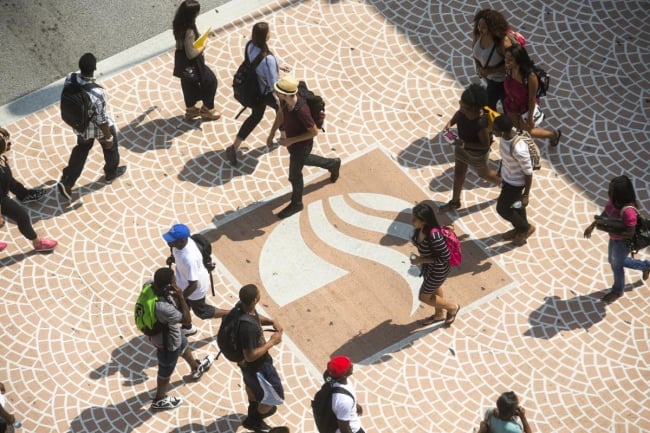You have /5 articles left.
Sign up for a free account or log in.

Georgia State University
When Georgia State University administrators realized they were barring about 1,000 students from enrollment every semester because they owed the university money, the university leaders knew they needed to come up with a plan that addressed financial obstacles to completion.
In 2011 they launched the Panther Retention Grant program, which covers students’ unpaid balances. The program is targeted at students in good academic standing, with a GPA of 2.0 or higher, who are at risk of being dropped from enrollment rolls because of outstanding debts of $2,500 or less. Eligible students, who have unmet financial needs after exhausting all other forms of aid, automatically receive the grant without having to apply.
“That was the impetus for the program, to try to address the attrition of really good students that were leaving us for really bad reasons—not because they didn’t want to be there and not because they couldn’t be there academically but because they didn’t have the money,” said Timothy Renick, executive director of the National Institute for Student Success at Georgia State.
Grants originally went to first-year students when the program first started, but now the majority go to seniors. Administrators made this change in 2014, hoping to maximize the impact of the program by getting more students to the finish line so they can complete their studies and graduate in less time. In its first year, the program awarded 214 grants; more than 10,000 grants have since been awarded.
A recent report by the research firm Ithaka S+R suggests the microgrant program helps students graduate in less time and with less debt on average.
“A program that helps students clear that last final obstacle and helps them get their degrees is important—and it’s the right thing to do,” said Daniel Rossman, a senior researcher at Ithaka S+R and a co-author of the report.
Rossman and the other authors of the report conducted two analyses to assess the outcomes of the program. One analysis compared students who received the grants to students who did not. The other compared students with outstanding balances, who may or may not have received the grants, to students without these debts to substantiate the first set of findings.
The analyses found that grants did help recipients graduate more quickly. Students who received a grant had significantly higher graduation rates than their peers within one term and three terms of getting the funds, though the difference in graduation rates between recipients and nonrecipients diminished over time.
Students who received the grants were enrolled for 0.44 fewer terms than their peers on average. Grant recipients also accumulated $3,700 less debt on average, including, federal, state and institutional student loan debt. The report suggests this is likely because they had to make fewer tuition payments. When examined separately, Pell Grant recipients and students from underrepresented backgrounds had similar outcomes.
However, the findings didn’t definitively show whether the grants helped students graduate who otherwise would not have. In the second analysis of the report, there was no difference in graduation rates within six terms among students with balances and without balances.
Even so, a speedier path to graduation has major benefits for students, Rossman said. He noted that students not only incur less debt but can enter the labor market earlier and begin paying off student loan debt faster.
Research shows even small outstanding debts to colleges can have lasting consequences. A previous Ithaka S+R report from 2020 estimated that about 8.3 million students nationwide had unpaid balances in the 2018 fiscal year, and over 1.4 million wound up with accounts in collections. Meanwhile, some institutions withhold the transcripts of students with unpaid balances, which prevents them from enrolling for classes or transferring to other institutions. An estimated 6.6 million students have stranded credits they earned but can’t access because of these debts, which can prevent them from continuing their education or securing jobs.
A wave of colleges—especially community colleges and historically Black colleges and universities—recently used federal COVID-19 relief funds to pay off students’ outstanding balances The colleges acted in response to the job losses and financial hardships students experienced during the pandemic, which led to droves of students stopping out.
Enrollment at Georgia State’s main campus in Atlanta, where the retention grant program was first implemented, has risen fairly steadily for over a decade, a trend that’s continued in spite of the pandemic. Enrollment increased from 35,052 students in fall 2019 to 36,304 in fall 2020. However, Renick said the sustained growth can likely be attributed to a range of factors, including federal COVID-19 relief funds, successful academic counseling and the use of chat bots to engage students, among other factors.
Rossman believes the study findings about Panther Retention Grants have broader implications for other colleges and universities looking to develop or fine-tune similar programs.
“I think the big takeaway is that retention or completion grants offer a promising solution to the problem of affordability in higher education,” Rossman said. “The right design and strategic implementation in these types of programs can play an important role in helping students remain enrolled through graduation, especially in a post-pandemic world with huge financial obstacles. I think it’s something that can be part of an institution’s tool kit to help students succeed.”
Not everyone is so sure. Completion and retention grants, which offer students small sums to help keep them enrolled, have become increasingly popular in recent years. However, some higher ed experts have raised concerns that completion grants may not be reaching the students who need them most.
The Hope Center for College, Community, and Justice at Temple University published the results of a randomized-control trial in December 2021, which examined outcomes of 11 university grant programs, not including Georgia State’s. The report found “no evidence of positive impacts on academic outcomes.”
Sara Goldrick-Rab, founder and president of the Hope Center, said Georgia State’s program jump-started a trend in higher ed, but she worries “completion grants might be going to the kinds of students who, despite financial challenges, have persisted towards the end and who would finish with or without the completion grants.” The report’s findings about Georgia State’s program have not convinced her otherwise.
She believes grant dollars would generally be better spent on first-year students and sophomores, in part because low-income students from underrepresented backgrounds drop out at higher rates before their senior year compared to white students from wealthier households.
Renick said it’s important to rigorously assess completion grant programs, and he’s grateful for studies like the Hope Center’s, but he pointed out that not all programs are alike. For example, he said some require onerous application processes. He believes the latest research on Panther Retention Grants demonstrates that these programs can save low-income students time and money if carefully designed. He also noted that supports for students earlier in their studies are crucial, but so are programs that serve students near the end of their college careers, particularly in Georgia. The state’s HOPE scholarships, which are merit based, only assist students for four years, so working students who may take longer to graduate can find themselves short on cash.
“You’ve got to test these things and figure out what works and what doesn’t work,” he said of retention and completion grant programs. “That’s how we improve, and that’s how we make any gains in science and gains in technology, and that’s what higher education and student success needs to do more of.”









